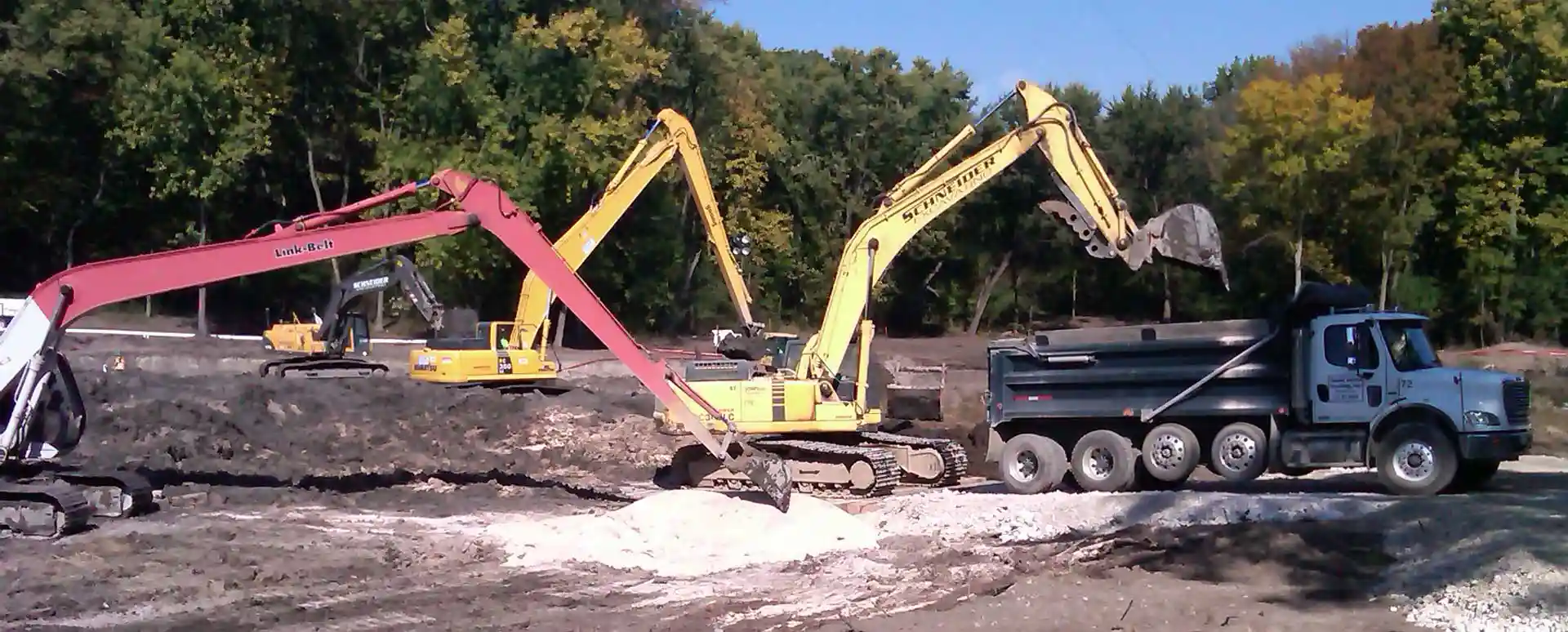What is Soil Remediation?

What is Soil Remediation?
Soil remediation is the application of proven technologies to mitigate and manage risks from contaminated soils that could be harmful to human health and the environment. Contaminated soil is often the result of historical industrial processes and unregulated waste disposal practices. Although these practices may have been in full compliance with all applicable laws, the negative impact was later realized thanks to advancements in testing methods. Soil contamination can originate from many sources including chemicals, improper disposal of industrial wastes, tank, and pipe leaks over long periods of time and spills of products of all types. Contaminants commonly found in soil remediation projects include solvents, paints, oils, heavy metals, pesticides, and other man-made compounds. As laboratory test methods continue to evolve, new compounds at contaminated sites will be identified. These new discoveries will generate data on compounds we could not see analytically in the past. New research discoveries will drive technology advancements in the soil remediation market to address complex clean up issues.
Let’s work together.
What is the Remediation Process?
Before a soil remediation project can start, there are several steps required to evaluate the best clean up strategies for any site. A comprehensive site investigation conducted by an experienced firm is critical to the long-term success of the project. The selection process for the environmental consultant that will conduct the investigation should focus on some critical points. Their technical expertise, experience with similar types & size projects, bench strength and their overall competency to handle the unknowns when site conditions change are all key factors to consider during the evaluation process.
The goal of the site investigation is to define the nature and the extent of the contamination at the site. Results from the investigation will provide key information that will be used to assess risks to human health and the environment as well as to formulate cleanup strategies. The information collected during the site investigation will also be the data used to determine feasibility of possible remediation strategies, applicable environmental regulations, cleanup standards, financial and legal aspects as well as end use options for the property after remediation. Final remedy selection will focus on minimizing the potential risk to human health and the environment.
Soil remediation falls into three primary categories: In-situ, ex-situ and other treatment. Under each category is a range of specialized technology and methods that may be required for any given project.
Both in-situ (in-place) and ex-situ (out of the ground) utilize some of the same methods for treating contaminants in soil. For contaminated sites with multiple contaminants and complex waste issues, some combination of all three categories may be required to complete remediation. Some commonly used treatment methods are physical / chemical treatment, bioremediation and thermal. Contaminated sites where in-situ methods are feasible will typically cost less and reduce long- term liabilities that are associated with offsite disposal. For sites that require an ex-situ remediation approach, the contractor will excavate the contaminated soil and then apply the appropriate treatment technology. By excavating and treating the contaminated soil, the contaminant levels are reduced to allow for the lowest disposal cost or the best reuse option for the treated soil. Soils contaminated with heavy metals, such as lead, are often excavated and treated onsite to meet the regulatory thresholds. This allows for a lower disposal cost option at a non-hazardous landfill.
Other treatment methods include transporting the waste to offsite commercial waste treatment facilities that are permitted to accept industrial and remediation wastes; including: hazardous waste treatment facilities, hazardous waste landfills, incinerators, thermal treatment and other specialized treatment companies. These companies have the capabilities to treat high volumes of wastes and provide secure disposal to minimize their customer’s long-term liabilities.
Types of Soil Remediation and the Different Methods Used
Below are some commonly applied treatment methods:
Physical and Chemical Treatment
- Solidification and Stabilization (S/S) is technology that has been widely used for environmental applications for decades. S/S are similar in that both use treatment reagents to achieve different treatment objectives to address the contamination. The most common reagents used in S/S include quicklime, Calciment® lime kiln dust (LKD), fly ash, and cement. The cementitious properties of the reagents change the physical condition of the soil or waste to encapsulate, dry and create a solid matrix. Solidification does not necessarily change the chemical structure of the contaminants.
- Stabilization refers to the mixing of reagents to chemically reduce the toxicity and the mobility of contaminates in a soil or waste. As stated with solidification, many reagents used in stabilization processes will also create a dry solid when the process is complete.
- Chemical oxidation uses a variety of liquid and dry reagents to convert contaminates to more stable, less toxic compounds using chemical reactions. The technology is widely used for in-situ and ex-situ applications as well as in the commercial treatment industry. The methods for delivering the treatment reagents to the soil will be by deep or shallow soil mixing using specialized equipment, pump and treat systems or direct injection.
Thermal Soil Remediation
Several thermal treatment technologies rely on the addition of heat to vaporize contaminates. In general, thermal treatment uses heat to destroy or drive off contaminates in the form of gas. The gas is treated further using a variety of methods.
- Low-temperature techniques heat the soil in dryers at temperatures ranging from 300 °F to 1,000 °F. This temperature range can volatize many soil contaminants before secondary treatment and eventual safe discharge to the environment. Petroleum hydrocarbons are treated using this method.
- Incineration techniques use high temperatures, ranging from 1,400 °F to 2,200 °F, to process certain soils. Rotary kilns are used for commercial needs while infrared combustion technologies are often associated with mobile processing systems. Further, circulating and fluidized bed combustors use rapidly moving air to generate a zone where turbulent combustion takes place. Cement kilns permitted to burn hazardous waste provide another viable thermal treatment option for some waste types.
Bioremediation
- Bioremediation of soil uses living organisms to degrade the soil. In essence, the biological activity removes or immobilizes soil pollutants. Soil bioremediation combines geology, chemistry, biology, and engineering principles. In-situ techniques use micro-organisms or plants to break down or fixate soil contamination. There are specific bacteria that can reduce certain compounds and certain plant species that can accumulate contaminates. Several ex-situ techniques use solids or slurries to treat contaminated soil. Most bioremediation projects require months or even years to complete the treatment process. Costs related to biological remediation are generally lower than other techniques. There are times when biological treatment may be the only feasible method due to building structures or other obstacles.
How Much Does It Cost to Remediate Soil?
Every soil cleanup project is unique with distinctive disposal issues and related costs. Experienced, field-proven environmental professionals should be involved from design to project completion. Performing environmental remediation correctly, the first time, will save time and money in the end.
In conclusion, each environmental remediation project is unique and involves many levels of decision-making. From the investigation, design and approval to the time of actual implementation in the field, a soil remediation project can take months or years for each stage. Engaging qualified partners and suppliers early in the planning process is critical to the overall success. Early discussions with reagent suppliers are also important. Logistics, supply, project timing and other technical matters are all factors that require preplanning and coordination. Bench scale treatability can prove a technology effective, but these studies often disregard the supply side of implementing the technology in the field. With all the components of a remediation project, proper planning and communication will save time and money in the end.
We're here to help you find the best solution for your next project. Let's get started. Give me a call at 937-641-9901.

Josh Weser
Mintek Resources
Related Posts
Unlocking Pavement Potential: The Long-Term Value of Chemically Stabilized Subgrades
A Foundation in Crisis America’s roadways are the backbone of its economy and daily life, yet they continue to show signs of chronic underinvestment. According to the American Society of Civil Engineers’ 2025 Infrastructure Report Card, the nation’s infrastructure...
Ground Control: Comparing Lime and Geosynthetics for Long-Lasting Stability
When building infrastructure on weak in-situ soils, a well-designed foundation is essential to ensure long-term resilience. Whether you're constructing roads, embankments, or industrial platforms, ensuring subgrade stability is critical—not just for performance, but...
Save Time and Money with Mintek’s Lime Stabilization Calculator
Lime stabilization turns challenging soils into durable foundations suitable for the construction industry. When lime-based reagents interact with soil, a chemical process alters its characteristics - binding clay particles, reducing plasticity & shrink-swell...